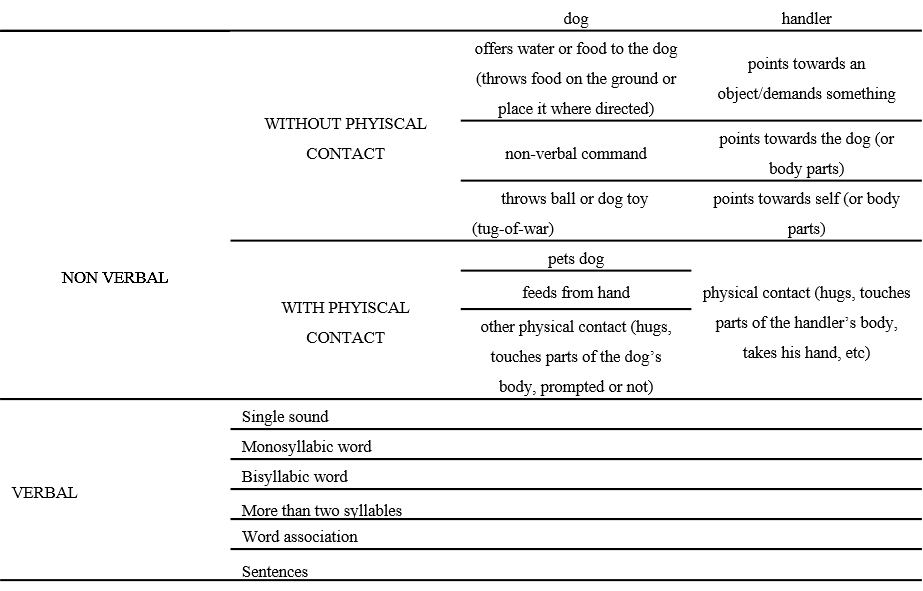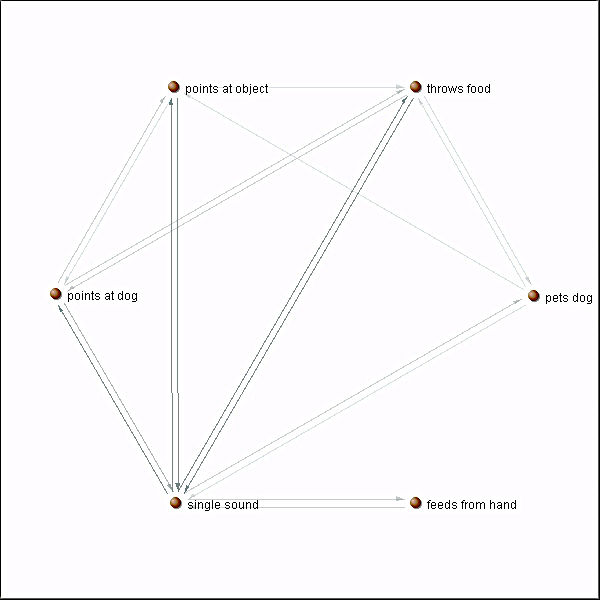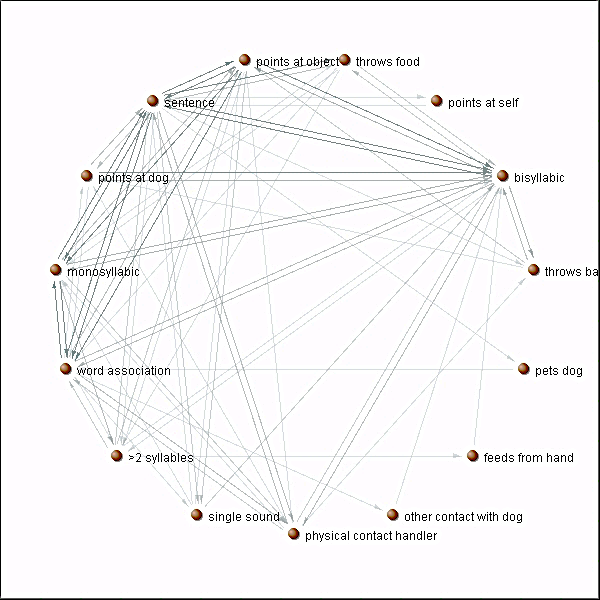Abstract
The study investigates the dynamic of verbal and non-verbal communication in the context of Animal Assisted Therapy for children with special needs, using ethological and sociometrical methods (i.e. focal individual sampling, ethogram and sequential behavior analysis). The study followed the evolution of a 5-year-old boy with mild mental retardation, ADHD symptoms and a very low level of verbalization, through one year of weekly AAT (dog assisted therapy) sessions. Each session had an average duration of 20 min. Behavioral analysis of the video recorded materials indicated a significant progress in speech development and a decrease of hyperactive symptoms. The implementation of the proposed methods (focal animal sampling and Social Network Analysis) allowed us to objectively analyze the complex interactions between the behavioral sequences, which usually can be very difficult to be extracted in a quantitative manner. The results supported our hypotheses in terms that the complexity of verbal communication increased throughout the five sessions of dog-assisted therapy, which were selected for the behavioral data analysis. Nonverbal communication towards the dog and the handler was also diversified towards the last session.
Keywords: Dog assisted therapyspeech developmentsequential behavior analysis
Introduction
A significant body of research investigating children’s interactions with animals indicates significant benefits for children, such as physiological (Odendaal, 2000), emotional and social (Anderson & Olson, 2006; Walters, Esteves, & Stokes 2008; Zasloff & Hart, 1999) and physical (Gee et al., 2007).
In a meta-analysis regarding the types and the outcomes of animal assisted programs, Nimer and Lundahl (2007) define Animal Assisted Therapy (AAT) as the „
Positive results regarding the improvement of social interactions, especially in therapeutic programs that have incorporated dogs, have been reported by several authors (Corson et al., 1977; Redefer & Goodman, 1989), such as significant increase in social interaction and decrease in solitude, isolation tendencies, especially in children with autism spectrum disorders (ASD); the effects were still measurable, though to a lesser extent, after the therapy ended. Nielsen and Delude (1989) performed a comparative study of children’s interactions with toy animals and real animals (dogs), indicating that the social catalyst effect of the real animal was associated with more significant health benefits.
Research in the area of AAT indicates that interactions with dogs often stimulate the motivation for social interactions of children with special needs with colleagues and adults. From the scientific literature we can conclude that interaction with dogs in the context of AAT is encouraged for one of the following reasons: (1) the dog offers a unique form of unconditioned social support for children with disabilities, dogs being often perceived as “special friends” (Anderson & Olson, 2006), (2) the dog’s spontaneous enthusiasm for social interaction can provide a stimulus for the child’s own social behavior (Prothmann et al., 2006) or (3) the dog can increase the positive interactions initiated by the educator (Limond et al., 1997; Walters, Esteves & Stokes, 2008).
Problem statement
Although the amount of systematic research in the area of Animal Assisted Therapy grew in the last twenty years, the drawback of many serious research in the attempt to bring forth evidence of the benefits of this kind of complementary therapy is often the lack of objective instruments to evaluate the therapeutic progress, both in measuring behavior and in the analysis of the resulted interactions between the animal and the child.
Research questions
The main objective of the present study is to investigate the effects of Animal Assisted Therapy (dog assisted therapy) on the improvement of communication skills of children with mental retardation.
The second objective is to propose implementation of the following methods as objective instruments for evaluating the therapeutic process in Animal Assisted Therapy: (1) focal animal sampling (for the data collection) and sequential and network analysis (for data analysis).
The following two hypotheses were tested: (1). The AAT intervention will be associated with an increase of the level of verbal and non-verbal communication of a child with mental retardation; (2) The AAT intervention will be associated with an increase of the behavioral diversity (occurrence of new behavioral sequences with relevance to the verbal and non-verbal communication) of a mentally retarded child.
Purpose of the study
The present research aims to offer an objective way of analysis of verbal and non-verbal communication in the context of animal-assisted activities, using ethological and sociometrical methods. We propose that this combination of methods can later be used for the analysis of behaviors other than the ones related to communication, in the context of therapeutic human-animal interactions.
The behavioral therapy school, as well as the systemic one, considers that the direct observation by a trained observer is one of the most reliable forms of data collection (Jacob, 1976). As in the aforementioned therapies, the data obtained through direct observation in AAT can be analyzed in various ways: they can be used to diagnose and analyze behavioral deficits (or excesses) within the interaction or they can be used as pre- and/or post-intervention evaluations. In AAT, several authors (Bradshaw & Cormack, 1997) prefer and recommend the use of video recordings and ethograms to investigate the behavioral change as a result of interaction with dogs.
Research methods
Focal animal sampling is an observation technique used in ethology (i.e. scientific study of animal behavior) to observe behaviors of individual animals, or a group of animals, through a limited period of time. The main advantage is that it allows observations of all behaviors occurring in a given period, even the ones that do not seem important or are less obvious at a first glance (Alcock, 1997).
Sequential analysis is a method that allows examination of the sequential relationship between each pair of behaviors and visualizing it as behavioral patterns (Bakeman & Gottman, 1997)
Social network analysis (SNA) is a sociometrical analysis method of social structures and communication networks (Otte & Rousseau, 2002). Network analysis is traditionally used to analyze the dynamic of groups of human or non-human individuals. In this research we substituted individuals with specific behaviors and analyzed the relationships between these behaviors.
The subject we analyzed is a 5-year-old boy, diagnosed with mild mental retardation and ADHD. He is an orphan and permanent resident of the center where the recorded therapy sessions took place (Bucharest, Romania). At the beginning of the intervention his verbal communication consisted only in isolated sounds. He was otherwise sociable and communicative, generally compliant and had slight reservations in interacting with dogs while playing in the center.
The current research was conducted within the “Dogs for People” Animal Assisted Therapy Program developed by the animal welfare foundation Vier Pfoten in Bucharest, Romania. The project uses exclusively former stray dogs that have been carefully evaluated, selected and trained by experiences and accredited dog trainers to become therapy dogs, in an effort of changing public mentality about stray dogs in Romania and other EU countries. Throughout the intervention, the child worked successively with three dogs, in order to prevent the development of preferences that might later on led to long-term attachment formation (Delta Society AAT guidelines; www.petpartners.org). The dogs used in the observed sessions were two mix breed dogs, a male and a female (adult dogs, 2-4 years old). The dogs were periodically treated against both internal and external parasites, and lived in optimal hygienic conditions (handler’s homes). Both dogs were adults especially selected for AAT, behaviorally tested and trained. The dog handlers were both men, first of which was a certified psychotherapist.
The intervention lasted one year (from 2008-2009) and it was structured in weekly sessions. The five sessions selected for analysis are evenly spaced in time and cover a one-year interval. The analyzed sessions lasted in average 20 minutes/session. Besides the child and the handler, in the room was also present a therapist from the Vier Pfoten Foundation and, occasionally, the psychologist from the residential home or other Vier Pfoten employees (TAA handlers). The sessions consisted of games involving the dog or tasks designed to reach specific objectives.
From the observed behaviors, the ones that were coded were the ones occurring more often and which were considered by the authors (based on the literature) to be of relevance for the assessment of social communication. The behaviors were coded according to

All the coded behavioral sequences were then analyzed using a platform-independent tool, i.e. Agna 2.1 (Benta, 2003), which is a general SNA desktop application allowing to create, edit and analyze social networks, i.e. types of successions and connections between several behavioral sequences in this case. Several sociometric coefficients can be calculated for each sequence and for each session of sequences, which offer information about the level of connectivity and communicational activity of each node of the network (Benta, 2005).
Findings
The analysis of the coded behaviors, both verbal and non-verbal, revealed a descending trend from the second until the fifth session in terms of types of sequences. As expected, considering the ADHD diagnosis and the multitude of new stimuli the child was exposed to (e.g. dog presence, therapist presence, dog’s toys etc.), the first session was the one with the fewest coded behaviors. Thus, in the first session, we recorded 108 verbal behavioral sequences and 45 non-verbal behavioral sequences. In the second session, we recorded 481 verbal behavioral sequences (an increase by 345.3%) and 240 non-verbal behavioral sequences (an increase by 433.3%). The number of non-verbal behaviors decreased from the second to the fifth session to 191 verbal and 67 non-verbal. Regarding verbalizations, our data indicate that the spoken language started to diversify towards the fifth session. Thus, if in the first session we only observed one type of verbal behavior (single sound), in the fifth session, all six coded levels of verbal complexity were observed. The descending trend of both categories (verbal and non-verbal behaviors) is logically explained by the fact that as the spoken language diversifies and refines, the need to communicate through gestures decreases. The frequency of non-verbal communication decreases from the first to the last session, while at the same time, the level of behavioral diversity (computed with Agna 2.1) increased. At the same time, we found that as the complexity of verbal communication increased, the overall quantity of verbalizations decreased, indicating a more efficient verbal communication.
The sequential analysis revealed that the session with the fewest significant (in terms of probability that the associations were not due to chance) behavioral sequences was the first session (two significant associations, both between the non-verbal behaviors towards the dog and verbal behaviors). The session with the most significant behavioral sequences was the fourth session with 24 significant associations. The significant associations of behaviors that occurred most often throughout the 5 analyzed sessions were between non-verbal behaviors towards the handler and verbal behaviors (18) and between non-verbal behaviors towards the dog and verbal behaviors (15).
The analysis if the graphic representations of the sequences (kinetic diagrams) and centrality indexes for each session revealed that, from one session to the other, new behavioral sequences appeared and the diversity of the connections between the nodes of each sequential network increased (Figures


Conclusions
Implementing the proposed methods (focal animal sampling and Social Network Analysis) allowed us to objectively analyze the complex interactions between the behavioral sequences, which usually can be very difficult to be extracted in a quantitative manner. Also, the results supported our hypotheses in terms that the complexity of verbal communication increased throughout the 5 sessions of dog-assisted therapy. The analysis of the sociometrical status of the network nodes shows that the most advanced verbal communication (sentence) has the highest informational status in the last session (i.e. numbers of sequences preceding and following the sentence; Figure
Given the interdisciplinary character of the AAT, we propose here an interdisciplinary combination of methods (ethology and sociometry) of evaluating the dynamic and the outcomes of animal assisted activities in therapeutic and educational settings.
One post-intervention observation, which was not directly investigated, was that as the spoken language developed, the ADHD symptoms decreased considerably in the case of the 5-years boy. This observation is supported by the scientific literature that indicates that the development of speech is closely tied to emotional regulation (Fox, 1994; Fujiki, Brinton & Clarke, 2002).
Limitations
The main limitation of the research is related to the fact that there was no control condition or an established baseline of the efficiency of the communication before starting the dog-assisted intervention. The current research assumed as base level the level recorded through the proposed methods in the first session. Another limitation that makes the generalization of the results difficult is the lack of control over the maturation effect, a limitation affecting many studies in the field of child development. Because the child we observed had a developmental delay, his curve of development is somewhat atypical and does not follow the curve of development expected in typically developed children. Another limitation is that, in quantifying the results, we did not take into account whether the relevant sequences were spontaneous, or whether they were associated with prompt from the adults (verbal, gestural or combination of prompting). A deeper analysis of the video recorded data would allow us to gather this type of information.
Acknowledgements
The authors would like to thank the Vier Pfoten Foundation for supporting this research and to the developer of Agna 2.1 for the freely distribution of the software.
References
- Alcock, J. 1997. Animal Behaviour, an Evolutionary Aproach. Sunderland, Sinauer Associates, 547 p.
- Anderson, K. L., & Olson, M. R. (2006). The value of a dog in a classroom of children with severe emotional disorders. Anthrozoos, 19:35–49.
- Bakeman, R., & Gottman, J.M. (1997). Observing interaction: An introduction to sequential analysis. New York: Cambridge University Press. 2nd edition.
- Benta, I.M. (2003). Agna 2.1. Users Manual (available online at www.geocities.com/imbenta/agna).
- Benta, I.M. (2005). Studying communication networks with Agna 2.1. In Studying Communication in Animals (Ed. Rusu, A.S.) ASCR, Cluj-Napoca, Romania.
- Corson, S. A., Corson, E. O., Gwynne, P. H. and Arnold, L. E. 1977. Pet dogs as nonverbal communication links in hospital psychiatry. Comprehensive Psychiatry, 18:61-72.
- Fox, N.A. (1994). Dynamic cerebral processes underlying emotion regulation. Monographs of the Society for Research in Child Development, 59:152-166.
- Fujiki, M., Brinton, B., & Clarke, D. (2002). Emotion regulation in children with SLI: Social adaptation or social deviance? Journal of Speech, Language, and Hearing Research, 41:688-700.
- Gee, N. R., Harris, S. L., & Johnson, K. L. (2007). The role of therapy dogs in speed and accuracy to complete motor skills tasks for preschool children. Anthrozoos, 20:267-276
- Jacob, T. 1976. Assessment of marital dysfunction. In: Behavioural Assessment: A Practical Handbook, 397–417, eds. M. Hersen and A. S. Bellack. New York: Pergamon Press
- Limond, J. A., Bradshaw, J. W. S. and Cormack, K. F. M. 1997. Behavior of children with learning disabilities interacting with a therapy dog. Anthrozoos, 10:84-89.
- Nielsen, J. A. and Delude, L. A. 1989. Behaviour of young children in the presence of different kinds of animals. Anthrozoos, 3:119-129.
- Nimer, J. & Lundahl, B. Animal-assisted therapy: A meta-analysis. Anthrozoos, 20:225-238.
- Odendaal, J. S. J. (2000). Animal-assisted therapy–magic or medicine? Journal of Psychosomatic Research, 49:275-280.
- Otte, E., Rousseau, R. (2002). Social network analysis: a powerful strategy, also for the information sciences. Journal of Information Science, 28:441-453.
- Prothmann A., Bienert M. & Ettrich C. (2006). Dogs in child psychotherapy: Effects on state of mind Anthrozoos, 19:265-277.
- Redefer, L. A. and Goodman, J. A. 1989. Brief report: pet-facilitated therapy with autistic children. Journal of Autism and Developmental Disorders, 19: 461-467.
- Walters Esteves, S., & Stokes, T. (2008). Social effects of a dog’s presence on children with disabilities. Anthrozoos, 21:5-15.
- Zasloff, R. L., & Hart, L. A. (1999). Animals in elementary school education in California. Journal of Applied Animal Welfare Science, 2:347-357.
Copyright information

This work is licensed under a Creative Commons Attribution-NonCommercial-NoDerivatives 4.0 International License.
About this article
Publication Date
22 December 2016
Article Doi
eBook ISBN
978-1-80296-017-4
Publisher
Future Academy
Volume
18
Print ISBN (optional)
-
Edition Number
1st Edition
Pages
1-672
Subjects
Teacher, teacher training, teaching skills, teaching techniques, special education, children with special needs
Cite this article as:
Chitic, V., & Rusu, A. S. (2016). An Interdisciplinary Approach of Animal Assisted Therapy for the Special Needs Children. In V. Chis, & I. Albulescu (Eds.), Education, Reflection, Development - ERD 2016, vol 18. European Proceedings of Social and Behavioural Sciences (pp. 101-108). Future Academy. https://doi.org/10.15405/epsbs.2016.12.14

